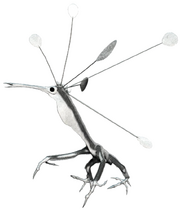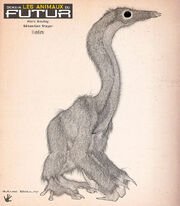
Sunset in the future. In the plain of Efremov, covered with water after a heavy rain, a male Cossima poses, quiet, at the foot of a Neophorbia.
Systematic: "Aves" (Bird), apodiform (group swifts and hummingbirds), trochilidae (hummingbirds group).
Etymology: "Cossima" Italian female name Cosima, which means harmony, order or universe in Greek.
Cousin of the 21st century: Patagona gigas, the giant hummingbird native to the Andes.
Size: The female can reach 30 cm long, while the male is 15 cm.
Distribution: Plain Efremov (remains of the Mediterranean Sea).

Male Cossima magnificens
Morphology: This hummingbird has lost the ability to fly; its wings have turned into long, thin claws. The neck is elongated and the beak is mostly covered by long, thin, colored skin. Only the male has extravagant feathers on top of the head, similar to small peafowl feathers.

Plain Efremov. Formerly the Mediterranean Sea, the salt plain is dotted with strange terrestrial algae and plants evoking cacti plants (Neophorbia wellsi). On some feet of funny birds (Cossima magnificens) domicile. Here a male is about to take a swig of nectar, soon ousted by a new intruder left.

Female Cossima magnificens
Ecology and ethology: The female, larger than the male, is insectivorous and nomadic. She wanders in search of the most beautiful male to mate with. This one features the same color as the plant - a Neophorbia - on which he lives. He makes the nest and started at the sight of a female, a song and a complex mating dance. Each species of Cossima lives in symbiosis on a kind of Neophorbia. The plant provides the cottage and its flowers cover, while the male by his droppings, produces an effective fertilizer. This hyper between the two symbionts is due to the fact that small male birds only eat one type of nectar.
Diversity: the species Cossima letissieri (named in honor of French singer and songwriter Héloïse Letissier) at slightly marked sexual dimorphism (females resemble males and vice versa), remains very rare, but recognizable by its dance complex and very refined song.
